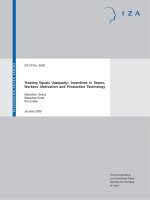Capacity and Multiplexing Architectures potx
Bạn đang xem bản rút gọn của tài liệu. Xem và tải ngay bản đầy đủ của tài liệu tại đây (1.15 MB, 40 trang )
1
8: MIMO II: Capacity and Multiplexing Architectures
Fundamentals of Wireless Communication, Tse&Viswanath
8. MIMO II: Capacity and Multiplexing
Architectures
2
8: MIMO II: Capacity and Multiplexing Architectures
Fundamentals of Wireless Communication, Tse&Viswanath
Outline
•
Transceiver architectures for fast fading (V-BLAST
family)
•
Transceiver architecture for slow fading (D-BLAST)
•
Multiple antennas in networks: SDMA
3
8: MIMO II: Capacity and Multiplexing Architectures
Fundamentals of Wireless Communication, Tse&Viswanath
Transmitter and Receiver CSI
•
Can decompose the MIMO channel into a bunch of orthogonal
sub-channels.
•
Can allocate power and rate to each sub-channel according to
waterfilling
4
8: MIMO II: Capacity and Multiplexing Architectures
Fundamentals of Wireless Communication, Tse&Viswanath
Analogy with OFDM
Major difference:
In MIMO, the U and V matrices depend on the channel H.
In OFDM, the IDFT and DFT matrices do not.
5
8: MIMO II: Capacity and Multiplexing Architectures
Fundamentals of Wireless Communication, Tse&Viswanath
Receiver CSI Only
The channel matrix H and its singular values λ
i
2
's are random and
unknown to the transmitter.
Has to fix a Q and a power allocation independent of H.
Q=I and uniform power allocation is optimal in many cases.
It is not trivial to come up with capacity-achieving architectures.
6
8: MIMO II: Capacity and Multiplexing Architectures
Fundamentals of Wireless Communication, Tse&Viswanath
Capacity
Can write:
Slow
fading:
Fast fading:
7
8: MIMO II: Capacity and Multiplexing Architectures
Fundamentals of Wireless Communication, Tse&Viswanath
Fast Fading Capacity for I.I.D. Rayleigh Fading
8
8: MIMO II: Capacity and Multiplexing Architectures
Fundamentals of Wireless Communication, Tse&Viswanath
d.o.f. determines the high SNR slope.
9
8: MIMO II: Capacity and Multiplexing Architectures
Fundamentals of Wireless Communication, Tse&Viswanath
Fast Fading Capacity: Low SNR
n
r
– fold power gain at low SNR
10
8: MIMO II: Capacity and Multiplexing Architectures
Fundamentals of Wireless Communication, Tse&Viswanath
Nature of Performance Gain
•
At high SNR (d.o.f. limited): min(n
t
,n
r
)-fold d.o.f. gain.
MIMO is crucial.
•
At low SNR (power limited): n
r
-fold power gain. Only
need multiple receive antennas.
•
At all SNR, min(n
t
,n
r
)-fold gain due to a combination of
both effects.
11
8: MIMO II: Capacity and Multiplexing Architectures
Fundamentals of Wireless Communication, Tse&Viswanath
System Question
•
Should one blindly overlay MIMO technology on CDMA
universal reuse systems?
•
These systems operate at low SINR.
•
MIMO gain is mainly receive antenna power gain.
•
Having multiple transmit antennas may not be
necessary.
•
Interesting implication on the uplink: expensive to have
many antennas at the mobile.
•
However mobile antennas are useful for the downlink.
•
They can also be used to suppress out-of-cell
interference and provide diversity.
12
8: MIMO II: Capacity and Multiplexing Architectures
Fundamentals of Wireless Communication, Tse&Viswanath
Transceiver Architecture: V-BLAST
•
Can get the performance gain by sending independent coded
streams at each of the Tx antennas and joint ML decoding.
•
Is this surprising?
•
Question:
–
How to get the d.o.f. gain even when streams interfere with each
other?
13
8: MIMO II: Capacity and Multiplexing Architectures
Fundamentals of Wireless Communication, Tse&Viswanath
Interference Nulling
Focusing on Tx antenna 1:
Simple strategy: null out the interference from other
antennas.
14
8: MIMO II: Capacity and Multiplexing Architectures
Fundamentals of Wireless Communication, Tse&Viswanath
Receiver Architecture I:
Bank of Decorrelators
15
8: MIMO II: Capacity and Multiplexing Architectures
Fundamentals of Wireless Communication, Tse&Viswanath
Bank of Decorrelators: Performance
i.i.d. Rayleigh
16
8: MIMO II: Capacity and Multiplexing Architectures
Fundamentals of Wireless Communication, Tse&Viswanath
Performance Gap of Decorrelator
Achieves the full d.o.f. min(n
t
,n
r
) of the MIMO channel.
(Same SNR slope.)
But:
There is still a substantial constant gap at high SNR.
At moderate and low SNR, performance sucks.
17
8: MIMO II: Capacity and Multiplexing Architectures
Fundamentals of Wireless Communication, Tse&Viswanath
Interference Nulling vs Match Filtering
Interference nulling: remove all interference at the expense of
reducing the SNR.
Match filtering: projecting onto h
1
to maximize the SNR but SINR
may be bad.
18
8: MIMO II: Capacity and Multiplexing Architectures
Fundamentals of Wireless Communication, Tse&Viswanath
Optimal Linear Filter:MMSE
Seek a linear filter that maximizes the output SINR at all
SNR.
Offers the optimal compromise between nulling and
match filtering.
It whitens the interference first and then match filter.
This is the linear MMSE filter.
19
8: MIMO II: Capacity and Multiplexing Architectures
Fundamentals of Wireless Communication, Tse&Viswanath
MMSE Filter
High SNR: MMSE ¼ decorrelator
Low SNR: MMSE ¼ matched filter
20
8: MIMO II: Capacity and Multiplexing Architectures
Fundamentals of Wireless Communication, Tse&Viswanath
Linear MMSE: Performance
21
8: MIMO II: Capacity and Multiplexing Architectures
Fundamentals of Wireless Communication, Tse&Viswanath
Gap at High SNR
•
MMSE improves the performance of decorrelator at moderate and
low SNR.
•
Does not remove the gap in performance at high SNR
•
To remove that gap we have to go to non-linear receivers.
22
8: MIMO II: Capacity and Multiplexing Architectures
Fundamentals of Wireless Communication, Tse&Viswanath
Successive Interference Cancellation
23
8: MIMO II: Capacity and Multiplexing Architectures
Fundamentals of Wireless Communication, Tse&Viswanath
MMSE-SIC Achieves MIMO Capacity
24
8: MIMO II: Capacity and Multiplexing Architectures
Fundamentals of Wireless Communication, Tse&Viswanath
Optimality of MMSE-SIC
Given a fixed channel H ,
Why is MMSE-SIC optimal?
MMSE is information lossless at each stage.
The SIC architecture implements the chain rule of
information.
25
8: MIMO II: Capacity and Multiplexing Architectures
Fundamentals of Wireless Communication, Tse&Viswanath
Fast vs Slow Fading
•
So far we have focused on the fast fading scenario.
•
Can V- BLAST achieve the outage capacity of the slow fading
channel?
•
No, cannot achieve transmit diversity.
•
In fast fading channels, transmit diversity is not important since
there is already plenty of time diversity.
•
In slow fading channels, there is no time diversity so coding across
transmit antennas becomes important.
•
Challenge is to combine this with SIC.









